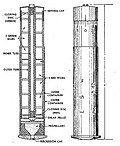| Leuchtpistole 34 | |
|---|---|
 A Leuchtpistole 34 from U-505 at the Museum of Science and Industry Chicago, IL. | |
| Type | Flare gun |
| Place of origin | Germany |
| Service history | |
| In service | 1934-1945 |
| Used by | Germany Denmark |
| Production history | |
| Designer | Walther |
| Manufacturer | Walther Erma Bernard Berhauss |
| Specifications | |
| Mass | 730 g (1 lb 10 oz) |
| Length | 245 mm (9.6 in) |
| Barrel length | 155 mm (6.1 in) [1] |
| Cartridge | Flare Smoke Panzerwurfkörper 42 Wurfgranate Patrone 326 Wurfkorper 361 |
| Caliber | 26.6 mm (1.05 in) |
| Action | Break action |
| Feed system | Single shot [1] |
The Leuchtpistole 34 or flare gun in English was introduced into German service before World War II and served throughout World War II.





